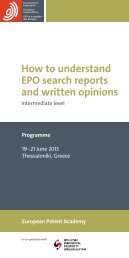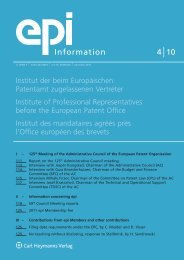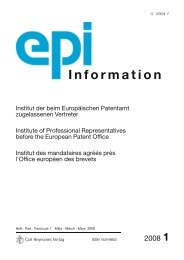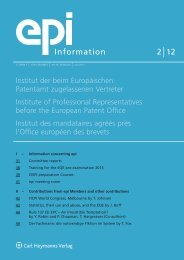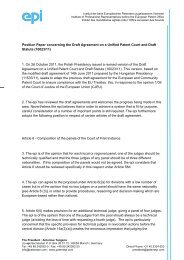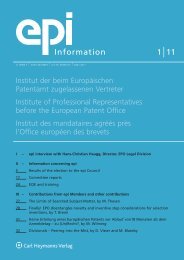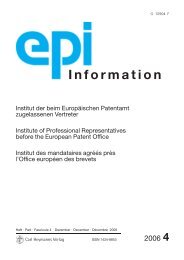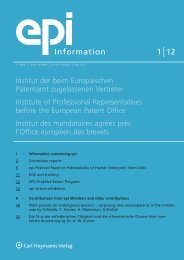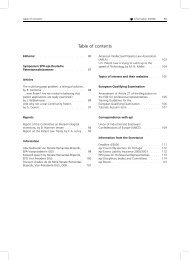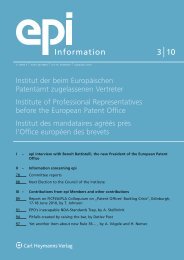epi Information 2/2009
epi Information 2/2009
epi Information 2/2009
Create successful ePaper yourself
Turn your PDF publications into a flip-book with our unique Google optimized e-Paper software.
56 Articles <strong>Information</strong> 2/<strong>2009</strong><br />
gave a brief update on our agenda, including the installing<br />
of a Director of Education and expressing a desire to<br />
exchange views with FICPI on any discussion paper<br />
which might emanate from the EPO AC on deferred<br />
examination. A FICPI president has a three year term<br />
between Congresses. Therefore Danny Huntington (US)<br />
stepped down and handed over to Peter Huntsman (AU)<br />
for a term expiring in 2012 at the next World Congress<br />
which will (probably) be in Australia.<br />
Study of priority right under EPC:<br />
same invention /disclaimers<br />
F. Portal 1 (FR)<br />
I – Preamble/Introduction<br />
As old as 1883, the „Paris Convention“ for the protection<br />
of Industrial Property established a Right of<br />
Priority of one year, relating to the same invention for<br />
which a protection is sought in different countries. The<br />
EPC priority right of article 87 is entirely based on the<br />
mechanism and interpretation of the Paris Convention<br />
and EPO’s decisions on the priority right often refer to<br />
the Paris Convention interpretation.<br />
Priority right is one of the essential mechanisms of the<br />
Patent Law, but also one of the most difficult to appreciate.<br />
To show this complexity we just have to refer to the<br />
recent past. A person may benefit a priority right in<br />
respect of a „same invention“, but contrary decisions<br />
were rendered on the interpretation of the concept of<br />
the „same invention“ until the Enlarged Board of<br />
Appeal’s G2/98 decision rendered in 2001.<br />
Very recently, a Board of Appeal rendered a decision<br />
T1443/05 on the interpretation of the „same invention“.<br />
In this particular case 2 successive EP applications were<br />
filed, one claiming the priority of the earliest one.<br />
II – Board of Appeal („BA“) decision T1443/05 –<br />
FACTS<br />
This is one important most recent decision from the BA<br />
on the priority right. This decision was held on EP<br />
1 005 271 (EP2) wherein claim 1 is basically directed to<br />
a biocide composition including at least two active<br />
ingredients, namely 2-methylisothiazolin-3-on (MIT)<br />
and 1,2-benzisothiazolin-3-on (BIT), excluding compositions<br />
including 5-chloro-2-methylisothiazolin-3-on<br />
(CMIT).<br />
This EP2 is a Euro-PCTapplication claiming the priority<br />
of an earlier EP application (EP1) published by the EPO<br />
under EP 0 900 525. The earlier EP1 was directed to<br />
biocide compositions including at least two active<br />
1 Frédéric Portal, European Patent Attorney, Chemistry, Chemical Engineering,<br />
Life sciences at Cabinet Beau De Loménie, Paris.<br />
ingredients, namely 2-methylisothiazolin-3-on (MIT)<br />
and 1,2-benzisothiazolin-3-on (BIT). According to the<br />
description these compositions may comprise other biocides<br />
such as CMIT.<br />
Thus, according to EP1, CMIT is a further possible<br />
biocide agent of the composition, but CMIT is excluded<br />
from the scope of claim 1 of EP2 by a disclaimer (i) to<br />
overcome a document from the prior art, namely JP<br />
01-224306, discovered in the Search Report, and (ii)<br />
justified further by alleged allergic properties of CMIT.<br />
III – Board of Appeal position in T 1443/05<br />
The Board held that the priority is not valid because the<br />
invention claimed in EP2 is not the same as the invention<br />
described in the earlier EP1.<br />
Article A. 87(1)(b) EPC states that a person may<br />
benefit of a priority right in respect of a „same invention“.<br />
According to G2/98, a narrow and strict interpretation<br />
of the „same invention“ is appropriate. For<br />
such an interpretation the claims for which a priority is<br />
claimed should be directly and unambiguously derived<br />
from the disclosure of the priority application.<br />
The Board interpreted that the invention claimed in<br />
EP2 is not the „same“ as the invention disclosed in the<br />
priority EP1 because of the disclaimer of CMIT. Thus the<br />
board held that the priority is not valid.<br />
On this basis the Board considered that the earlier<br />
European patent application EP1 is opposable as regard<br />
to novelty of the subsequent EP2 according to A.54(3)<br />
EPC (prior rights).<br />
Because the examples of the earlier EP1 disclose a<br />
combination of MITand BITwithout CMIT, the Board held<br />
that the priority document EP1 destroys novelty of EP2’s<br />
claims, and revoked EP2.



